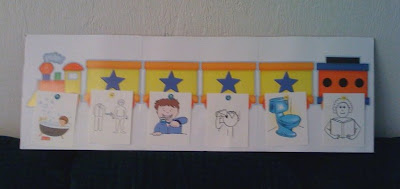 This is a visual schedule I created to show a bedtime routine. Cards can be flipped over once completed.
This is a visual schedule I created to show a bedtime routine. Cards can be flipped over once completed.Q: Why do we use visual schedules?
A:
1. To reduce anxiety/frustration! In order to communicate successfully, we need to know what is expected of us. Young children especially thrive on predictability!
2. Provide motivation to work through a less favored activity knowing a favored one follows.
3. To promote independent behavior.
4. To teach skills required for daily learning.
5. To reduce the possibility that challenging behaviors will occur.
6. To reinforce time organization and sequential memory.
Q: Who benefits from using a visual schedule?
A: Almost everyone can benefit. Consider the child’s ability to UNDERSTAND rather than the ability to speak. A visual schedule is especially important to children that may have difficulty understanding oral language and directions. Children with autism show strengths in the areas of rote memory and understanding visual information.
Q: How do I indicate changes on a visual schedule?
A: Once is in place, stick to the schedule as much as possible. If life interferes, return to the schedule as soon as possible. If a change must be made, a question mark can indicate a new activity.
A visual schedule should be:
Left to right, as in reading or top to bottom
Child manipulated
At least two items at a time so children learn events aren’t isolated but happen in sequence
Taught and practiced
Used with consistency
Most of us learn objects and actions through the following common levels of abstraction
Actual objects and actions
Photographs of objects and actions
Black and white line drawings of objects and actions
Written words which describe objects and actions
Use whatever makes the connection for the individual, decreasing the level of abstraction if the individual seems confused or frustrated.
When designing, ask:
1. Will the child understand or recognize the pictures or words?
2. Is the activity represented by the visual schedule obvious to the child?
3. Can the schedule be made clearer by the use of words, more images, or objects?
4. Does the child know and have available the tools required to successfully complete the activity?
A:
1. To reduce anxiety/frustration! In order to communicate successfully, we need to know what is expected of us. Young children especially thrive on predictability!
2. Provide motivation to work through a less favored activity knowing a favored one follows.
3. To promote independent behavior.
4. To teach skills required for daily learning.
5. To reduce the possibility that challenging behaviors will occur.
6. To reinforce time organization and sequential memory.
Q: Who benefits from using a visual schedule?
A: Almost everyone can benefit. Consider the child’s ability to UNDERSTAND rather than the ability to speak. A visual schedule is especially important to children that may have difficulty understanding oral language and directions. Children with autism show strengths in the areas of rote memory and understanding visual information.
Q: How do I indicate changes on a visual schedule?
A: Once is in place, stick to the schedule as much as possible. If life interferes, return to the schedule as soon as possible. If a change must be made, a question mark can indicate a new activity.
A visual schedule should be:
Left to right, as in reading or top to bottom
Child manipulated
At least two items at a time so children learn events aren’t isolated but happen in sequence
Taught and practiced
Used with consistency
Most of us learn objects and actions through the following common levels of abstraction
Actual objects and actions
Photographs of objects and actions
Black and white line drawings of objects and actions
Written words which describe objects and actions
Use whatever makes the connection for the individual, decreasing the level of abstraction if the individual seems confused or frustrated.
When designing, ask:
1. Will the child understand or recognize the pictures or words?
2. Is the activity represented by the visual schedule obvious to the child?
3. Can the schedule be made clearer by the use of words, more images, or objects?
4. Does the child know and have available the tools required to successfully complete the activity?

No comments:
Post a Comment